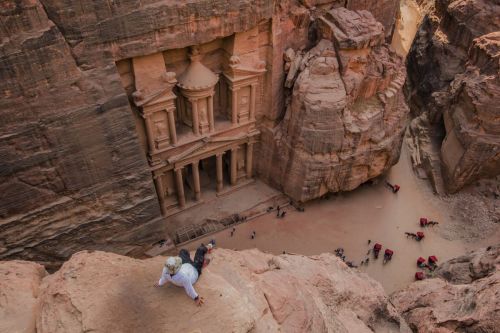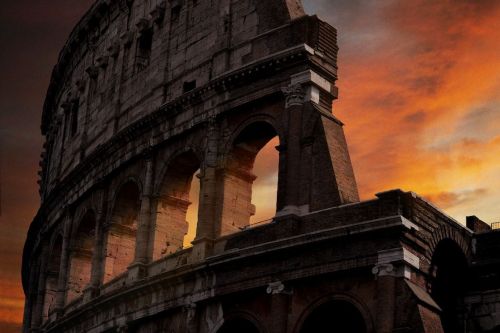The ancient fortress located on the Dead Sea was the site of bloody battles between Jewish insurgents and the Romans.
The Zealots' attitude in defending the fortress became for modern Israelis a symbol of heroic resistance to the very end. Faced with imminent defeat, it was decided to commit collective suicide, and the end of the siege was tantamount to the end of the Jewish uprising, which had lasted for seven years.
Masada corresponded most closely to the term "mountain fortress" both in terms of its geographical location and its external appearance. The apartment summit of Masada, which rises 410 meters above the Dead Sea, is diamond-shaped and measures 600 meters in length and about 320 meters in width. The summit is defended by steep slopes several hundred meters high. The mountain itself was already a natural defensive site.
It was built by the high priest Jonathan, who also gave it its name - the name is Hebrew: məṣādā = "fortress".
Who Jonathan was is disputed. Some scholars associate the figure of High Priest Jonathan with Judah's brother Maccabeus (one of the leaders of the Jewish uprising against the Seleucids), while others, based on the data that Alexander Jannaeus of the Hasmonean dynasty was king and at the same time held the title of High Priest, and that Jannaeus is a short form of the name Jonathan, consider that Masada was built by King Alexander Jannaeus (king of Judea from 103 BC).
Masada fortress was located in a sun-baked desert area, far from cities (about 50 km from Jerusalem) and fertile valleys, on the edge of the dry Dead Sea basin.
In 40 BC Herod was fleeing from the Parthians (the Parthian kingdom was in ancient Iran) and Antigonus of the Hasmonean dynasty (king of Judea from 40 BC).
Appreciating the strategic location of Masada, he sought refuge there with his family. He then had 800 of his best soldiers placed in the fortress and set out for Rome himself to get help. Soon after, the siege of Masada led by Antigonus began.
Upon his return from Rome, Herod gathered an army of mercenaries and Judeans and set out to liberate Masada. After conquering the fortress, already as king of Judea (since 37 BC), he decided to expand and fortify it.
A garrison of Roman soldiers was stationed there.
Under the command of Menachem, one of the leaders of the uprising against the Romans, the Sicarii disbanded the Roman garrison and manned the fortress with their own men. They had a large supply of food that had accumulated since the time of Herod (and was suitable for consumption thanks to the dry climate and the way it was secured and stored).
Thanks to crops, they also had fresh food and raised livestock. They had access to water, which was stored in reservoirs created in the past.
About 1,000 people lived in the fortress, including many women and children. The defense of Masada was led by Eleazar ben Jair, who was related to Menachem.
The army included the 10th Legion Fretensis (a legion formed by Octavian, probably in Sicily, specialized in siege operations) and 6 auxiliary cohorts.
The defenders of Masada found themselves in a very difficult position. Surrounded by perfectly armed and trained Roman legions, they had practically no chance of survival.
This was an expression of despair, but also of great pride and courage in the face of inevitable defeat, for the defenders of Masada refused to surrender to the rule of the hated Romans.
The men killed their families and burned all their belongings on a common funeral pyre. Then they drew ten from their midst who slaughtered the others. When these were dead, a drawn sicarius killed nine comrades, then set fire to the palace and ran himself through with a sword. Food was left as proof that the defenders had not starved.
In the morning, when the Romans crossed the fortress walls, they found 960 corpses. Only two women and five children survived, as they had been hidden in a canal. This means that there were 967 people in Masada.
In the following centuries, the fortress was the scene of battles during another Jewish uprising (132-135) and was later occupied by Byzantine monks who had to flee Masada as a result of either Persian or Arab invasions in the 7th century.
What remains of them are the ruins of a small chapel, which testify to the existence of Christianity in the area. Since then Masada has not been inhabited.
Swearing-in ceremonies are regularly held at the ruins for Israeli soldiers, who take a military oath that reads, "Masada shall never fall again."
The Western Palace, with its wall paintings and mosaics and one of the largest bathhouses in the Middle East, is partially preserved. The Northern Palace is preserved as well as a ritual bathhouse and a synagogue built by Herod, considered the oldest in Israel.
Many interesting items from the time of Herod, the Jewish uprising and the time when monks lived there have been discovered. Particularly noteworthy are fragments of papyrus and parchment scrolls containing biblical and apocryphal texts.
The top of the plateau can be reached by a cable car or by a hollowed-out path through the rock. To this day, Masada is shrouded in legends and mysteries that have accumulated over the centuries.












